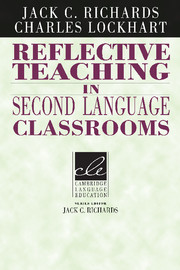Book contents
- Frontmatter
- Contents
- Series editor's preface
- Preface
- Introduction: Teacher development through exploring classroom processes
- 1 Approaches to classroom investigation in teaching
- 2 Exploring teachers' beliefs
- 3 Focus on the learner
- 4 Teacher decision making
- 5 The role of the teacher
- 6 The structure of a language lesson
- 7 Interaction in the second language classroom
- 8 The nature of language learning activities
- 9 Language use in the classroom
- Epilogue
- References
- Index
8 - The nature of language learning activities
Published online by Cambridge University Press: 29 January 2010
- Frontmatter
- Contents
- Series editor's preface
- Preface
- Introduction: Teacher development through exploring classroom processes
- 1 Approaches to classroom investigation in teaching
- 2 Exploring teachers' beliefs
- 3 Focus on the learner
- 4 Teacher decision making
- 5 The role of the teacher
- 6 The structure of a language lesson
- 7 Interaction in the second language classroom
- 8 The nature of language learning activities
- 9 Language use in the classroom
- Epilogue
- References
- Index
Summary
This chapter examines lessons in terms of the activities teachers use to achieve their instructional goals. An activity is described as a task that has been selected to achieve a particular teaching/learning goal. Research on teaching (e.g., Clark and Yinger 1979) suggests that the notion of activity is central to an understanding of teaching. It influences both how teachers conceptualize teaching as well as the ways they organize their lessons. In this chapter, the kinds of activities commonly used in ESL classes are described and the decisions that teachers have to consider when planning and using activities are discussed.
Lesson planning usually begins with consideration of general goals for a lesson, and then leads to decisions about the kinds of activities which will help attain these goals. Rather than breaking down the goals into behavioral objectives and then developing activities to match objectives, however, teachers often develop objectives as they plan specific teaching activities (see Chapter 4). According to Macdonald (1965) and Eisner (1967), it is while developing activities themselves that consideration of objectives becomes important, for this is where “ends for learning become integrated with means for learning” (Clark and Yinger 1979: 232). Activities are, hence, “the basic structural units of planning and action in the classroom” (Clark and Yinger 1979: 237). Nunan (1989b: 17) similarly observes:
[Teachers] tend to see lessons or units of work as the basic building blocks of their programmes. These lessons and units in turn are composed of sets of more or less integrated tasks and manipulative exercises of various sorts. […]
- Type
- Chapter
- Information
- Reflective Teaching in Second Language Classrooms , pp. 161 - 181Publisher: Cambridge University PressPrint publication year: 1994

